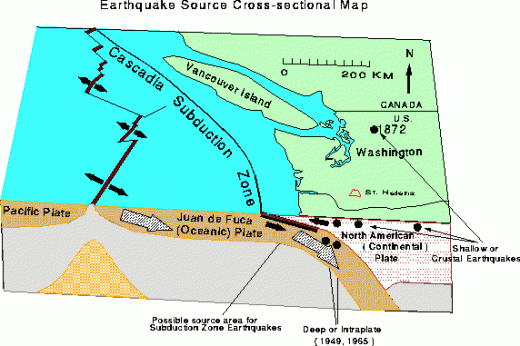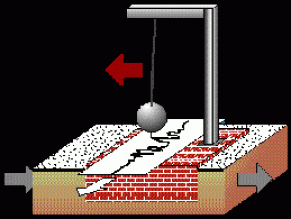What is an Earthquake?
An earthquake is a shaking of the ground caused by the sudden breaking and movement of large sections (tectonic plates) of the earth's rocky outermost crust. The edges of the tectonic plates are marked by faults (or fractures). Most earthquakes occur along the fault lines when the plates slide past each other or collide past each other.Earthquakes occur in all types of weather, in all climate zones, in all seasons of the year, and at any time of day making it impossible to predict with any certainty when an earthquake is likely to occur.
Types of Earthquakes
Subduction Zone Earthquakes
When an oceanic plate gets pushed underneath a continental plate it will often stick instead of sliding smoothly. A large amount of stress builds up over time and may be released suddenly as a large earthquake.
Deep Earthquakes
Deep earthquakes occur within the Juan De Fuca Plate as it sinks into the mantle. These earthquakes occur approximately 25-100 kilometers in depth. Due to their depth, aftershocks are not usually felt. History indicates that these earthquakes do not occur east of the Cascade Mountains.
Shallow Earthquakes
Shallow earthquakes occur within the North American Plate itself. These kinds of earthquakes are believed to be caused by stress transmitted from the Cascadia Subduction Zone into the interior of the North America plate. They generally occur at depths of 30 kilometers or less and have occurred throughout Washington and most parts of Oregon.
How are earthquakes recorded?
Earthquakes are recorded by instruments called seismographs. The recording they make is called a seismogram. The seismograph has a base that sets firmly in the ground, and a heavy weight that hangs free. When an earthquake causes the ground to shake, the base of the seismograph shakes too, but the hanging weight does not. Instead the spring or string that it is hanging from absorbs all the movement. The difference in position between the shaking part of the seismograph and the motionless part is what is recorded.
What are Plate Tectonics?
The theory of plate tectonics is a interesting story of continents drifting from place to place breaking apart, colliding, and grinding against each other. The plate tectonic theory is supported by a wide range of evidence that considers the earth's crust and upper mantle to be composed of several large, thin, relatively rigid plates that move relative to one another. The plates are all moving in different directions and at different speeds. Sometimes the plates crash together pull apart or sideswipe each other. When this happens, it commonly results in earthquakes.
Who studies earthquakes?
Geologists and seismologists (scientists who study earthquakes and the processes that create them) have found that earthquakes occur repeatedly at faults, which are zones of weakness in the earth's crust.
What causes an earthquake?
There are about 20 plates along the surface of the earth that move continuously and slowly past each other. When the plates squeeze or stretch, huge rocks form at their edges and the rocks shift with great force, causing an earthquake. Think of it this way: Imagine holding a pencil horizontally. If you were to apply a force to both ends of the pencil by pushing down on them, you would see the pencil bend. After enough force was applied, the pencil would break in the middle, releasing the stress you have put on it. The Earth's crust acts in the same way. As the plates move they put forces on themselves and each other. When the force is large enough, the crust is forced to break. When the break occurs, the stress is released as energy which moves through the Earth in the form of waves, which we feel and call an earthquake.
What is a Richter scale and how is it used?

The Richter scale is a scale designed by A. Richter to measure the strength or intensity of the shock waves produced by an earthquake. The scale is measured in steps from one upward. Each successive unit is ten times more powerful than the one before. Therefore an earthquake that measures 7.0 on the Richter scale is 1000 times more powerful than an earthquake measuring 4.0. Little damage is done by an earthquake below 4.0; an earthquake of 7.0, however, would cause widespread disaster.
How do scientists measure the size of an earthquake?
The size of an earthquake depends on the size of the fault and the amount of slip on the fault, but that’s not something scientists can simply measure with a measuring tape since faults are many kilometres deep beneath the earth’s surface. So how do they measure an earthquake? They use the seismogram recordings made on the seismographs at the surface of the earth to determine how large the earthquake was (figure 5). A short wiggly line that doesn’t wiggle very much means a small earthquake, and a long wiggly line that wiggles a lot means a large earthquake.



